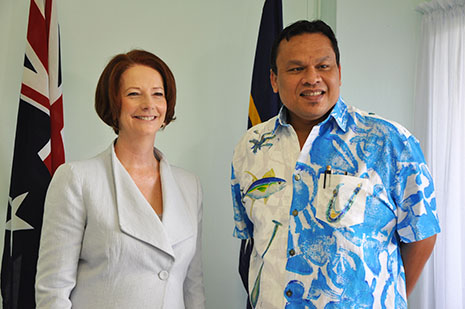THE passage of the Migration Legislation Amendment (Regional Processing and Other Measures) Act 2012 has cleared the way for the implementation of the most controversial of the recommendations of the expert panel on asylum seekers, chaired by Angus Houston: establishing the capacity to process refugee claims on Nauru and PNG in ways consistent with the international law responsibilities of Australia and the host country. All that remains to be done under domestic law is for the immigration minister to designate Nauru and PNG as regional processing countries. Once the legislative instruments have been tabled in each house of federal parliament for five sitting days without being disallowed, the designations will come into force. Since the Coalition parties support processing of asylum seekers in the two locations there is no possibility that parliament will disallow the designations.
The governments of Nauru and PNG have both agreed to host asylum seeker processing centres. Australia and PNG have, in fact, had a legally non-binding Memorandum of Understanding Relating to the Transfer to and Assessment of Persons in Papua New Guinea, and Related Issues in place since 19 August 2011. Shortly after that memorandum of understanding, or MOU, was signed, the High Court of Australia handed down its decision in the M70 case, casting grave doubt on the domestic lawfulness of the contemplated transfers from Australia to PNG. Now that the Migration Act has been amended to overturn that decision, further negotiations have commenced between Australia and PNG which may result in changes to the existing MOU.
On 29 August 2012, Australia and Nauru signed a legally non-binding MOU Relating to the Transfer to and Assessment of Persons in Nauru, and Related Issues. The similarities and differences between the two MOUs are telling in their own ways. The similarities suggest that, in large part, what is now being done in purported implementation of the Houston recommendations is what the Australian government would have done anyway. The differences give the lie to the Australian government’s claim that it does not propose to “cherry pick” those recommendations.
The preambles of the PNG MOU and the Nauru MOU both refer to the Regional Cooperation Framework adopted at the Bali Process Ministerial Conference in March 2011, and one of the objectives of each MOU is “to continue discussions as to how the Assessment Centre” – which is called a Regional Processing Centre in Nauru’s case – “might over time undertake a broader range of functions under the regional cooperation framework.” The only significant difference between the two preambles is the addition in the latter of “the need to ensure, so far as possible, that no benefit is gained through circumventing regular migration arrangements” (a key principle of the Houston report). The only difference between the objectives clauses (clauses 1 to 3 of each MOU) is the absence from clause 1 of the Nauru MOU of the reference to “deterrence” in clause 1 of the PNG MOU. The omission is probably explained by the fact that the language of deterrence was eschewed by the expert panel.
The PNG MOU sets out the following guiding principles:
4. All activities undertaken in relation to this MOU will be conducted in accordance with international law and the international obligations of both Participants.5. The Government of Papua New Guinea will conduct all activities in respect of this MOU in accordance with its Constitution and all relevant domestic laws.
6. The Government of Australia will bear all Costs incurred under this MOU.
Clause 5 of the Nauru MOU contains the same undertaking by Nauru as was made by PNG under clause 5 of the PNG MOU. Clause 6 of the Nauru MOU differs from clause 6 of the PNG MOU by referring to Australia bearing “all costs incurred under and incidental to this MOU as agreed by the Participants.” For its part, the PNG MOU contains a commitment by Australia to provide the PNG government with financial and other assistance in the management of PNG’s borders (clause 14), which has no equivalent in the Nauru MOU. The really significant and concerning difference between the guiding principles is that the Nauru MOU contains no equivalent of clause 4 of the PNG MOU. Instead, clause 4 of the Nauru MOU states that “The Commonwealth of Australia will conduct all activities in respect of this MOU in accordance with its Constitution and all relevant domestic laws.”
The Nauru MOU does contain assurances (which have no equivalent in the PNG MOU) that Nauru:
• will make, or permit to be made, assessments of whether a transferee is a refugee; and
• will not send transferees to a country in which they are likely to face persecution or danger of particular kinds (clause 14).
The Nauru MOU also contains, as does the PNG MOU, commitments by both Australia and the host country that they:
• will ensure that transferees “will be treated with dignity and respect and that relevant human rights standards are met” (clause 12 of both MOUs); and
• will develop special arrangements “for vulnerable cases including unaccompanied minors” (clause 13 of both MOUs).
But these commitments fall far short of Nauru assuring Australia that it will conduct MOU activities in accordance with all its international legal obligations and Australia doing the same in return. In drafting the Nauru MOU, which postdates the Houston report, the Australian government has gone out of its way not to heed the report’s recommendation that processing in Nauru and PNG should be done in accordance with the international legal obligations of both Australia and the host country – a fact that does not portend at all well.
Clauses 7 to 18 of each MOU deal with the operation of the MOU. Rather astoundingly, both Nauru and PNG have been prepared to sign off on a clause (clause 7) which states that Australia “may transfer” and that they “will accept” persons who have travelled irregularly by sea to Australia (or have been intercepted or rescued at sea by Australian authorities in the course of trying to reach Australia irregularly) and whom Australia determines should be transferred to PNG or, in Nauru’s case, are required by Australian law to be transferred to Nauru (clause 9). Since both MOUs can only be varied by the joint decision of Australia and the other country (clause 15) and remain in operation until terminated by mutual agreement (clause 18), it seems very much like Nauru and PNG have agreed to be recolonised by Australia.
Clause 10 of each MOU deals with the establishment of the processing centre or centres. The PNG MOU states that PNG “will establish an Assessment Centre in Manus Province.” The Nauru MOU states that Australia and Nauru “will establish a processing centre at a site or sites to be jointly determined and agreed.” The work of establishing capacity in Nauru has already commenced. According to the Australian immigration minister, Nauru will have a capacity of 500 people by the end of September. The combined capacity of the processing centres in Nauru and PNG once all construction is completed is likely to be 2100 people. At the time of writing (1 September 2012), the number of irregular maritime arrivals who had arrived in Australia since 13 August 2012 and were awaiting transfer to a “regional processing country” had already reached 1030.
EACH of the MOUs contains a “timing” clause (clause 11) specifying how long PNG and Nauru will be expected to host a given asylum seeker. Differences between these timing clauses, coupled with the difference in the preamble of the two MOUs mentioned earlier, means that PNG and Nauru have been placed in radically different positions.
Clause 11 of the PNG MOU states: “The Government of Australia will guarantee that all persons entering Papua New Guinea under this MOU will have left within as short a time as is reasonably necessary for the implementation of this MOU.” There is an arguable case that this means as soon as processing is complete. Clause 11 of the Nauru MOU states: “The Commonwealth of Australia will make all efforts to ensure that persons entering Nauru under the MOU will depart within as short a time as reasonably necessary for the implementation of this MOU, bearing in mind the objectives set out in the Preamble and Clause 1.” That is, as short a time as is necessary to ensure “that no benefit is gained through circumventing regular migration arrangements.” In other words, not as soon as processing is completed but rather only after the individual in question, if found to be a refugee, has waited as long for resettlement as they would have waited if they had been processed in “places like Jakarta and Kuala Lumpur and Pakistan.” On present estimates this would be a period of many years.
Curiously, Nauru’s foreign minister, Kieren Keke, said after finalising the MOU that he had been assured by the Australian government that assessment “will be done as quickly as possible and efforts to re-settle them either in Australia or elsewhere will also be done with energy and as quickly as possible.” It is difficult to escape the conclusion that the Nauruan government was misled about the content of the document it was signing by clever drafting and smooth talk.
Most of the practical details of the arrangements remain to be negotiated (clause 8 of each MOU). Each MOU provides (clause 17) that:
The Participants will establish a Joint Committee with responsibility for the oversight of practical arrangements required to implement this MOU including issues relating to the duration of stay of Transferees. The Joint Committee will meet regularly no less than once monthly and will be co-chaired by mutually agreed representatives of the Australian High Commission [in Port Moresby/Nauru] and [the PNG Immigration and Citizenship Service/Republic of Nauru]. Participation in the Joint Committee will be as agreed but may include relevant non-government organizations and service providers where appropriate.
Will the detailed protections and welfare arrangements envisaged by the Houston Panel and touted by them as distinguishing Pacific Solution Mark II from its infamous predecessor be implemented? The less than satisfactory answer is that we will have to wait and see. I, for one, am not holding my breath. •




